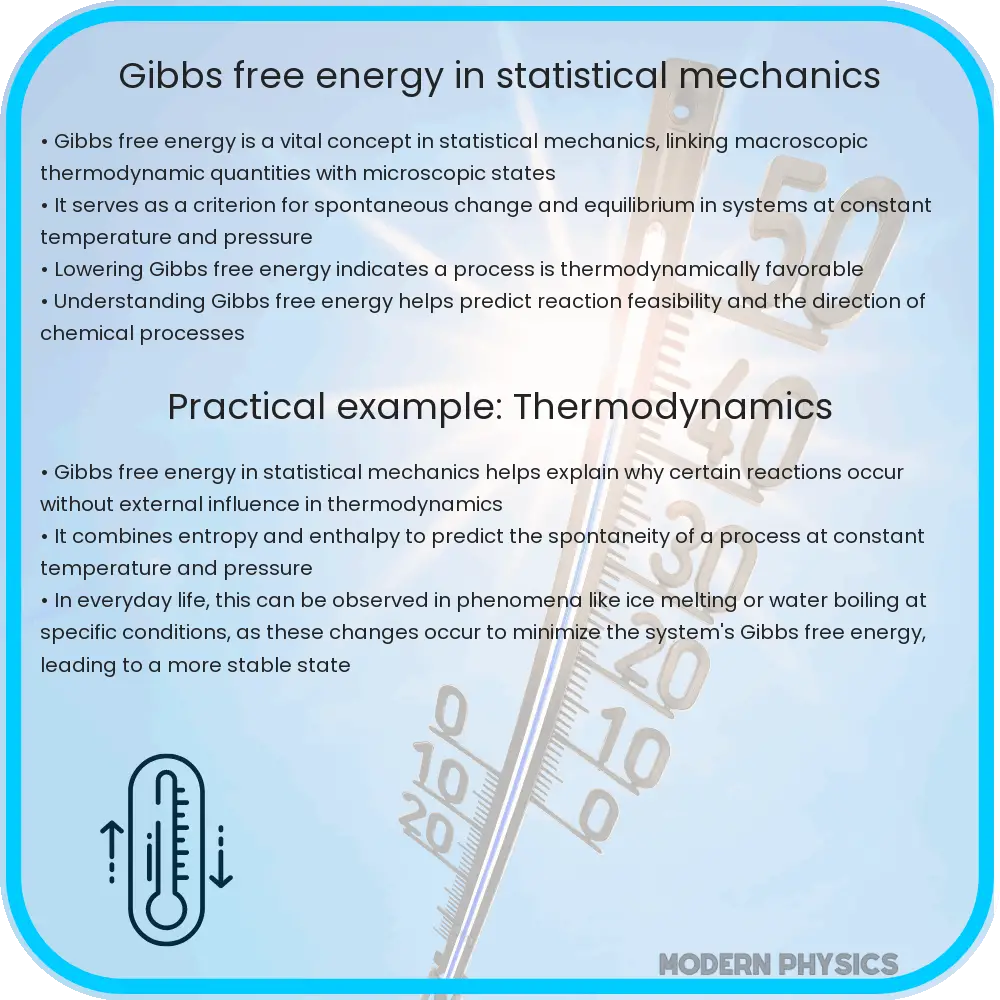Gibbs Free Energy is a thermodynamic quantity essential for predicting the behavior of systems in chemical reactions and phase transitions.

Understanding Gibbs Free Energy
Gibbs Free Energy, named after the scientist Josiah Willard Gibbs, is a thermodynamic quantity that is extremely useful in predicting the behavior of systems in chemical reactions and phase transitions. It combines the enthalpy (heat content), entropy (measure of disorder), and temperature of a system to provide a criterion for predicting and understanding its spontaneity and equilibrium states.
Defining Gibbs Free Energy
The Gibbs Free Energy (G) of a system is defined by the equation:
G = H – TS
where H represents the enthalpy of the system, T is the temperature in Kelvin, and S is the entropy. This equation shows how Gibbs Free Energy balances the trade-offs between enthalpy and entropy that determine spontaneity.
Spontaneity and Equilibrium
A fundamental principle in thermodynamics is that a process will be spontaneous if it leads to a decrease in Gibbs Free Energy, i.e., ΔG < 0. Conversely, if ΔG > 0, the process is non-spontaneous and requires external energy to proceed. When ΔG = 0, the system is at equilibrium and no net change occurs.
This concept helps scientists and engineers understand and predict the direction of chemical reactions and the conditions under which they occur.
Phase Transitions and Gibbs Free Energy
Phase transitions, such as melting, evaporation, or freezing, are also governed by changes in Gibbs Free Energy. During a phase transition, the system moves from one phase to another while the temperature and pressure remain constant. In this context, the condition ΔG = 0 must be met for the phase transition to occur.
To further understand this, consider the transition from ice to water. At 0°C and standard atmospheric pressure, the Gibbs Free Energy change (ΔG) from solid to liquid becomes zero. This indicates equilibrium between the ice and water, and it is this equilibrium that makes the melting of ice a spontaneous process at this temperature and pressure.
Calculating Gibbs Free Energy Changes
The change in Gibbs Free Energy during a reaction or phase change can be calculated from the enthalpies and entropies of the reactants and products:
ΔG = ΔH – TΔS
where ΔH is the change in enthalpy, and ΔS is the change in entropy. A negative ΔG indicates that a process is energetically favorable and capable of occurring without external intervention.
This calculation is essential in industries and research for optimizing conditions that maximize the efficiency of chemical processes and material transformations.
Applications of Gibbs Free Energy
Gibbs Free Energy is not only a theoretical concept but also a practical tool used across various disciplines. For example, in biochemistry, Gibbs Free Energy helps understand enzyme kinetics and how metabolic pathways are regulated. In environmental engineering, it is crucial for assessing the spontaneity of pollutant degradation processes.
Moreover, in the materials science field, the concept of Gibbs Free Energy assists in determining the stability of different phases of materials under varied environmental conditions. This understanding is vital for the development of new materials with desired properties and behaviors.
Insights from Gibbs Free Energy
Understanding the implications of Gibbs Free Energy can offer profound insights into the fundamental nature of physical and chemical processes. By studying the changes in free energy, scientists can predict system behaviors, manipulate conditions to steer reactions, and even innovate new technologies designed around energy efficiency.
This predictive power is invaluable in industries where cost-efficiency and optimization are paramount. Furthermore, in academia, Gibbs Free Energy provides a framework for explaining and experimenting with complex chemical and physical systems, contributing to scientific breakthroughs and a deeper understanding of the universe.
Conclusion
In conclusion, the concept of Gibbs Free Energy is a cornerstone in the study of thermodynamics, providing essential insights into the spontaneity, equilibrium, and energy requirements of chemical reactions and phase transitions. Its applications extend far beyond the classroom, influencing fields such as biochemistry, environmental engineering, and materials science. By integrating the principles of enthalpy, entropy, and temperature, Gibbs Free Energy helps bridge the gap between theoretical science and practical engineering solutions. Understanding this concept not only enhances our knowledge of the physical world but also empowers innovators to design more effective and sustainable technologies. As we continue to explore and manipulate the energies of chemical systems, Gibbs Free Energy will remain a vital tool in both research and industry applications.
